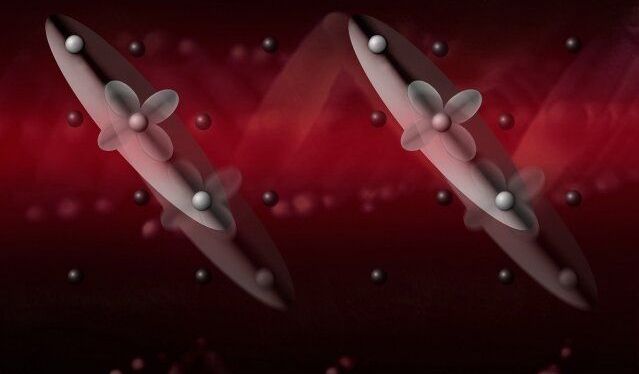These bricks are made out of desert sand, but are as strong as concrete.
Category: materials – Page 286

Physicists use extreme infrared laser pulses to reveal frozen electron waves in magnetite
Magnetite is the oldest magnetic material known to humans, yet researchers are still mystified by certain aspects of its properties.
For example, when the temperature is lowered below 125 kelvins, magnetite changes from a metal to an insulator, its atoms shift to a new lattice structure, and its charges form a complicated ordered pattern. This extraordinarily complex phase transformation, which was discovered in the 1940s and is known as the Verwey transition, was the first metal-insulator transition ever observed. For decades, researchers have not understood exactly how this phase transformation was happening.
According to a paper published March 9 in Nature Physics, an international team of experimental and theoretical researchers discovered fingerprints of the quasiparticles that drive the Verwey transition in magnetite. Using an ultrashort laser pulse, the researchers were able to confirm the existence of peculiar electronic waves that are frozen at the transition temperature and start “dancing together” in a collective oscillating motion as the temperature is lowered.

An engineered cell-laden adhesive hydrogel promotes craniofacial bone tissue regeneration in rats
Researchers have found that homeowners who seed their lawns with a special grass mix can feed dozens of species of bees that would otherwise go hungry. So, beginning this spring, Minnesota will pay thousands of residents to plant “bee lawns” under a new state program that has attracted attention from other states. Each homeowner will get as much as $350 to do the work.
Why grass mix brings all the bees to the yard.
Superconductor transition switches single-molecule magnet
Novel phenomenon occurs due to quantum tunnelling and might be exploited in future quantum information technologies.

Researchers one step closer to creating organic batteries
York University researchers have discovered a way to make Lithium-powered batteries more environmentally friendly while retaining performance, stability and storage capacity.
Lithium-ion batteries use toxic, heavy metals which can impact the environment when they are extracted from the ground and are difficult to dispose of safely. Cobalt is one of those heavy metals, used in battery electrodes. Part of the problem is that lithium and cobalt are not abundantly available, and supplies are dwindling.
Using organic materials are the way forward and that has scientists like Professor Thomas Baumgartner of the Faculty of Science and his team busy developing and testing new molecules to find the right ones to replace the rare metals currently in use.

Crystal creates a supercontinuum breakthrough
Researchers have generated a wide range of colors from a single laser after discovering a new process for achieving so-called “supercontinuum generation.”
Supercontinuum generation is when intense laser light of one color travels within a material, like glass, and broadens into a spectrum of colors.
The effect lets scientists produce light at colors tailored to particular applications in sectors like bioimaging, optical communications and fundamental studies of materials.

Researchers create the Jimi Hendrix of lasers
Photonics experts at Heriot-Watt university are hailing a breakthrough in laser research.
They have come up with a new and relatively inexpensive way of creating a laser supercontinuum.
They hope it could eventually have applications in bio-imaging and optical communications.
Generation of a supercontinuum happens when intense laser light of a single colour travels through a material and then broadens into a spectrum of colours.

Batman Day: How much has Bruce Wayne spent on being Batman over the years?
What I used to think was a basic suit for batman is anything but normal if it were true. It would cost about 1 million to make a real life one and the fabrics and materials might as well be alien because they are so exotic but look like fabric. If batman were real it would show how genius of science he truly is as his fabric technology is some of the most creative work any material scientist could ever dream of. Essentially it is like having a tank in a lightweight suit.
Happy Batman Day! DC Comics first created Batman Day for Batman’s 75th anniversary in 2014, and has continued to celebrate the Dark Knight on Sept. 23 each year since. While Harley Quinn has been trying to steal Batman’s thunder (happy 25th, Harls) this year, we still want to take a closer look at the guy who started it all.
A few years ago, MoneySupermarket.com put out an excellent infographic about the cost of being Batman. They used numbers based on The Dark Knight trilogy of films from Christopher Nolan, which means they were using modern technology (and values). But they only looked at base costs, not at ongoing numbers, and the base costs alone were astounding: $682 million just to become Batman. Based on those starting numbers, how much has Bruce Wayne spent on being Batman over the years? We’ll start with their numbers, and break it down based on the DC Comics sliding timeline; thanks to the New 52 reboot, where Bruce had been Batman for “about 7 years,” and assuming at least a year or two has passed since then, let’s go with nine years of Batman-ing.


Scientists Finally Observe Long-Predicted Form of Magnetism
Scientists believe they’ve made a concrete example of an unusual, theoretical form of ferromagnetism first described by a researcher more than 50 years ago.
Nagaoka ferromagnetism, named for the scientist who discovered it, Yosuke Nagaoka, is a special case of the same magnetic forces that make regular, refrigerator-type magnets work—ferro meaning iron, plus a few other metals that are naturally receptive to magnetism. Identifying it in real life—in this case using a quantum system of electrons—can help scientists understand how spontaneous ferromagnetism works.

Plastic-eating caterpillars have gut bacteria that can live on polyethylene for over a year
“The problem of plastic pollution is too large to simply throw worms and there is still a lot to do before we can parlay this work into making a meaningful contribution,” Cassone said. “Also, the larvae tend to eat less plastic with longer times on that type of diet. By understanding the process – why the breakdown of plastic occurs so rapidly in the waxworm—we can then begin to develop ways to really make a meaningful impact to plastic pollution.”
He continued: “Now that we know the microbiome plays a role, if we can better understand how the bacteria works together with the worm and what kind of conditions cause it to flourish, perhaps this information can be used to design better tools to eliminate plastics from our environment.”
Not all are convinced, however. Till Opatz, from the Department of Chemistry at the Johannes Gutenberg University, Germany, was critical of the initial findings that caterpillars digest plastic. At the time he and his colleagues said they disagreed with the methodology and conclusions reported, adding the study “does not provide sufficient proof” that G. mellonella can chemically destroy polyethylene.